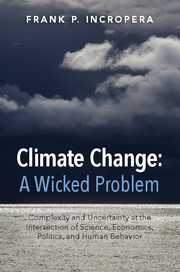 Climate Change: A Wicked Problem
Climate Change: A Wicked Problem Published online by Cambridge University Press: 05 October 2015
Basic elements of a complete end-to-end CCS system include CO2 capture and compression, transport from the source to a repository, and monitoring the status of the sequestered CO2 over time. Each element contributes to the total cost of CCS. Capture and compression costs increase with decreasing concentration and pressure of CO2 in the gas stream from which it is extracted, while transport costs increase with increasing distance from the source to the storage site. Costs of monitoring the sequestered CO2 are relatively small.
The cost of carbon capture for coal-fired power plants depends on the type of power plant, its efficiency, and whether the carbon is captured by pre- or post-combustion processes. To understand these options, it's helpful to first examine the makeup of a conventional plant. Consider the system shown in Figure E.1.
Pulverized coal (PC) and air enter the boiler, where the coal is burned to produce high-temperature products of combustion (POC). As the POC pass over tubes within the boiler (the steam generator), heat is transferred to pressurized water flowing through the tubes, converting it to steam. The steam is then routed through a set of steam turbines, where work is done on the turbine blades, enabling the turbine shaft to do work on an electric generator. To reduce losses in transmission by the grid, the voltage is increased by a transformer before the electricity enters the grid. The turbine has multiple stages to accommodate reheating in the boiler and to maximize the efficiency with which work is done by the steam. After leaving the last turbine stage, the steam is converted to water in a condenser and passed through a series of feedwater heaters and pumps before returning to the boiler to repeat the process.
To save this book to your Kindle, first ensure no-reply@cambridge.org is added to your Approved Personal Document E-mail List under your Personal Document Settings on the Manage Your Content and Devices page of your Amazon account. Then enter the ‘name’ part of your Kindle email address below. Find out more about saving to your Kindle.
Note you can select to save to either the @free.kindle.com or @kindle.com variations. ‘@free.kindle.com’ emails are free but can only be saved to your device when it is connected to wi-fi. ‘@kindle.com’ emails can be delivered even when you are not connected to wi-fi, but note that service fees apply.
Find out more about the Kindle Personal Document Service.
To save content items to your account, please confirm that you agree to abide by our usage policies. If this is the first time you use this feature, you will be asked to authorise Cambridge Core to connect with your account. Find out more about saving content to Dropbox.
To save content items to your account, please confirm that you agree to abide by our usage policies. If this is the first time you use this feature, you will be asked to authorise Cambridge Core to connect with your account. Find out more about saving content to Google Drive.